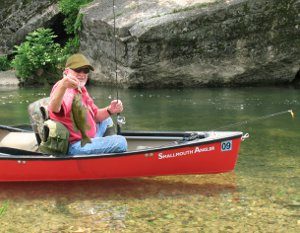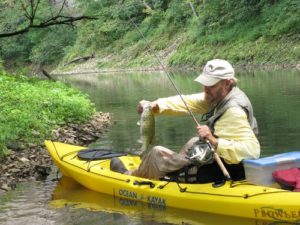
The fertile mid-south region from Oklahoma all the way to North Carolina has rivers with towering limestone bluffs. This one is in Arkansas.
My affair with limestone goes back a long way. Growing up around steep hills and rocky ridges, some of my earliest smallmouth bass fishing was in the local limestone-laden streams. In love at first sight, I was immediately captivated by the look of these streams as they twisted past golden bluffs and rushed over ragged riffles.
Almost as quickly, I came to appreciate these waters for their fish — especially the smallmouth bass they yielded. As a 14-year-old, I might not have been well-schooled in stream biology, but I already knew from firsthand experience that limey waterways offered great angling. A lifetime later, I’m still sold on waters rich with limestone. Though I pursue smallmouth bass in many locales, I make it a point to fish limey smallies every chance I get. Postcard-pretty scenery for my eyes, lots of fishy water for my rod.
Basic geology explains why limestone exists where it does. For an area to have limestone, in geological history it needed to be covered with ancient oceans and also be missed by “modern” glaciers. In the ancient ocean there was an accumulation of countless shellfish dying and settling to the sea floor. The hardened remains of these long-ago creatures is what geologists call sedimentary rock, primarily limestone. But glaciation scours away most sedimentary rock, so limestone primarily occurs in southern areas, which were bypassed by recent glaciers.
Why is Limestone So Good?
Basic biology and limnology explains why rivers flowing through limestone-rich soils are so productive. As the stone slowly dissolves, it creates highly alkaline water, which is excellent for invertebrates like aquatic insects. This means the base of the food chain is plentiful, which in turn supports lots of species such as minnows and crayfish– the forage smallmouth bass primarily depend on. Conversely, many less-alkaline waters have a much lower forage base.
Plenty of times I’ve noted this big disparity in fertility. While conducting smallmouth bass schools, I often do a “forage assessment” for my students. In limestone streams, examining rocks and seining a few eddies turns up a plethora of critters. Invariably, rocks are covered with aquatic insects and the seine bulges with minnows, shiners, chubs and crayfish. My stream surveys outside the limestone zone are far less productive. Rock residents are sparse, and often only a few craws and minnows turn up in the net.
Limestone streams have a couple other attributes. Since they’re mostly in the southern regions, they are warmer than rivers farther north. Warmer conditions mean faster growth rates and a longer growing season, for both smallmouth bass and forage species. I also think the jagged breaks and fissures common in big pieces of limestone benefit smallmouth bass. These irregular breaks create protected nooks and crannies, where smallies can escape during high water/strong current periods. Combined, these factors mean an acre of highly fertile limestone water can support several times more smallmouth bass than does the same amount of water in less-fertile regions. A mile of limestone stream may hold 350 smallies, but a similar length of lower-alkaline stream might only have 100 bass.
The downside to limestone streams in the farmbelt or in urbanized areas is heavy erosion from farm fields or development. This can silt over the rocky substrates. Additionally, intense flooding (from channelized feeder creeks) can limit smallmouth bass reproduction and reduce water visibility.
River Habitat– Up, Down or In Between?

Great Scenery, great fishing. Gotta love that limestone.
The interplay of both these positive and negative factors call for fishing techniques specifically tailored to limestone streams. First, you should understand that a stream isn’t a single monolithic entity. Generally, limestone waterways can be divided into three distinct sections. The upper river is often the most rocky and least silty section. Good numbers of smallmouth bass will be present. At the same time, the small size of the upper stream and lack of deep pools will limit the number of lunkers. Likely only creek-sized, the upper reaches are primo for on-foot fishers who like lots of good action from 10- to 14-inchers.
But don’t assume you’ll never connect with anything over a pound and a half. In several of my favorite headwater creeks, there are some deeper pools which yield surprisingly big smallmouth bass. These are superb places for light tackle. With a little effort and expertise you, too, can find these 16- to 18-inch treasures.
Compared to the upper river, the middle reaches of many limestone rivers have more deep water, yet aren’t overly silty. They can support good numbers of smallmouth bass as well as plenty of bigger boys. Since they offer both nice sizes and high numbers of bass, the middle sections are the most popular, especially if they are large enough to float by canoe and kayak. Besides lots of smallies to 14 inches, dandies over 16 inches should also regularly turn up.
Unfortunately, the lower (downstream) portions of many agricultural streams are the recipients of considerable sand and silt from upstream erosion. On larger rivers, this means limited rocky habitat and lower fish densities. But even in these less-than-optimum conditions, good fishing can still be had. While smallmouth bass catch rates may not be spectacular, anglers targeting the best water (usually the river’s outside bends that are scoured out) can still score with a few bigger bass. Those who can accurately recognize the best water and quickly move from spot to spot will see the most action. And not just from smallmouth bass. The lower reaches hold lots of other species, too, like walleyes, catfish, drum and white bass.
When They’re Hot, When They’re Not
Besides choosing where to fish on a stream, when to try a particular waterway is an important consideration. Because spawning success on erosion-impacted streams is erratic, smallmouth bass densities can vary greatly. A warm, dry spring and summer will add up to an explosion of young-of-year smallies, in turn leading to hordes of 13-inchers four years later. Conversely, 4 or 5 consecutive years of poor spawning results in few available fish.
One way to avoid these reproductive slumps is to seek out waters where spawning is more consistent. Generally, streams with wooded watersheds offer the most consistent reproduction (successful at least every other year). The other way to hit a hot bite is to target streams that had “baby booms” a few years previously. When a fertile limestone stream has a year of great spawning, smallies seem to be everywhere. Not only will the better pools have swarms of smallmouth, but so will even marginal habitat.
Hit one of these hot streams and you’re in for action-packed excitement. With so many eager fish competing with each other, using a fast-moving lure is smart. You’ll be able to quickly skim off the most active smallmouth bass and maybe score a 40- or 50-fish day. Sometimes, the local DNR office or a nearby tackle shop can point you to one of these high-density streams.
On less-known waterways, I conduct my own “spawning surveys.” During late summer I’ll stop at 3 or 4 bridges and quickly work the water with a very small spinner or jig. If reproduction was good 15 months earlier, I’ll catch lots of 7 and 8-inchers. If so, I know to return in a couple more years when the fish become footers.
Sometimes, years of poor spawning will lead to low densities of smallmouth bass and you’ll have to work for every nibble. In these lean times, skip the shallow runs, micro-eddies and other marginal habitat. Concentrate your efforts on the deepest, most cover-laden pools. Realize that now each smallie has its pick of spots and an excess of forage. Instead of making fast casts in a willy-nilly manner, methodically and slowly work the prime lies. Use a larger offering, perhaps a bottom-bouncing jig. It might take a number of casts to coax a strike, and expect just 2 or 3 bass per spot rather than a half-dozen or more.

Even small limestone creeks like this one can offer some fine fishing, as Tim can attest.
Cool Limestone
Smallies everywhere respond poorly to big drops in water temperature, but for some reason fish in limestone waters seem particularly sensitive. Fishing can be great for several days and then an extra-cool night or cold rain will push the water temperature down several degrees. For a day or two, fishing will be noticeably slower. Fortunately, fish activity will likely pick up quickly once the water warms or the fish acclimate to the cooler temperatures. Therefore, the best solution is to simply avoid those streams that have recently experienced a temperature decline of at least 5 or 6 degrees.
Murky Limestone
Muddy water is another fact of life on rivers that are heavily impacted by agriculture or other watershed degradation. If, after a heavy rain, a stream is the color of strong coffee and still rising, it’s best to look for more hospitable water. But if water levels have stabilized and it’s only moderately muddy, you can still do some business. In fact, one foot of water visibility often produces a surprisingly good bite. The secret is making the smallies an offer that they can find in all that turbidity.
One way to sucker dirty water smallmouth bass is by throwing high-visibility offerings. Ultra-bright colors such as fluorescent yellow, chartreuse and white are my favorites for dirty water. And whatever you use, make it big. Larger offering are naturally more visible and they also likely give off more vibration as they’re retrieved.
Love Your Limestone Rivers
If you have limestone-rich rivers in your region, you likely have a wealth of good smallmouth bass fishing available. If you regularly fish these gems, you already know why I love limestone. And part of loving lime is to do your part to protect these rivers. Join a conservation group and speak up against erosion and silt-producing land use. Your other mission is to get out on these rivers and learn them well. And I hope these tips will make your fishing time even better.


No comments yet.